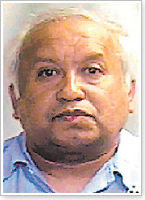LEFT IN LETHAL LIMBO
Tudo em: http://todaywnews.blogspot.com/
The end that awaits Alfonso Rodriguez Jr., barring a legal reversal of fortunes, requires him to be strapped down to a gurney and injected with a mix of lethal chemicals. The serial sex offender, convicted in 2006 of raping and murdering Dru Sjodin, is one of 55 inmates waiting on federal death row. His conviction remains on appeal, but the method of execution called for in his sentence has been challenged on the grounds that it violates constitutional protection against “cruel and unusual” punishment. Earlier this month, the U.S. Supreme Court heard arguments for and against what’s called the three-drug “cocktail” method of lethal injection,
by far the nation’s most widely used means of execution.
Because North Dakota doesn’t have the death penalty, the judge selected South Dakota law as the template for Rodriguez’s execution, which remains unscheduled, pending the outcome of his appeal.
South Dakota is one of 37 states that have adopted the three-drug series of injections. Ironically, states flocked to the method after other methods, principally electrocution and the gas chamber, increasingly came under court challenges.
Many death sentences around the country have been on hold since the U.S. Supreme Court agreed to hear the case more than a year ago, in December 2006, according to the Death Penalty Information Center.
Both the prosecution and defense in the Rodriguez case say it’s likely the constitutionality of the triple-drug method will be decided before the appeals in his case. Federal death penalty appeals typically take from six
to eight years, said Drew Wrigley, the U.S. attorney for North Dakota.
“It’s a moot point,” he said.
Defense briefs to challenge Rodriguez’s conviction are due next month, almost a year after the former Crookston, Minn., man was sentenced to death.
If successful, the lethal injection challenge would not overturn the death penalty, which consistently has been upheld. Instead, it likely would lead to a different method of lethal injection, lawyers said.
One likely replacement would be a single injection, an overdose of barbiturates, the method veterinarians routinely use to humanely put pets to sleep.
“We’re going to at least do as well with humans as we do with animals,” said Richard Dieter, executive director of the Death Penalty Information Center. In fact, some states prohibit animals from being put to sleep by the three-drug method, which critics say is not based on sound medical research.
In recent years, botched injections, with condemned prisoners reportedly grimacing or taking prolonged periods to die, have called the humaneness of the cocktail into question.
One problem: Many doctors and other health professionals refuse to take part in executions, leaving the injections to corrections officers who lack medical training.
The first cocktail drug should render the prisoner unconscious, to spare him from what follows: a second drug that paralyzes his muscles, and the final injection, to stop the heart.
If improperly administered, however, the patient suffers because his paralyzed muscles prevent him from breathing, and from the potent drug used to stop the heart, said Richard Ney, one of Rodriguez’s defense lawyers and an active death penalty opponent.
“One can imagine the horrible death that would be,” Ney said. “It would be excruciatingly painful. It’s a horrible, burning, ravaging poison.”
The reason for the first two drugs, to make the inmate unconscious and paralyzed, primarily are to spare witnesses by masking the pain experienced by the executed prisoner, Ney said.
“I’m not sure why the states are fighting this,” he said. Lethal injection, with its sense of clinical sterility, was a way of giving a falsely humane face to execution, Ney added.
“This was an effort to placate society,” he said. Lethal injections of barbiturates take longer, 20 or 30 minutes, and the person may twitch involuntarily. That may be unpleasant for witnesses, but the prisoner apparently suffers no pain, Ney said.
In fact, society is becoming increasingly troubled by the death penalty, Dieter said. Executions peaked in 1999 and have been declining since then for a variety of reasons.
One reason, he said, are highly publicized cases in which condemned prisoners have been exonerated by DNA evidence. That heightens awareness of the possibility wrongful convictions resulting in death, Dieter said.
“Who knows how often that happens,” he said. “Life without parole gives jurors and judges an out.”
Also, death penalty appeals drag on for years and are costly. The average death penalty case in Texas, which executes the most prisoners, is about $3 million. In California, where executions are rare, the average cost is much higher, more like
$125 million, Dieter said.
By contrast, life in prison without parole costs an average of $125,000, he added, or $5 million for a prisoner whose life term runs 40 years. “Death penalty cases are in the multimillions when everything is taken into account.”
Finally, Dieter said, many are unconvinced of the deterrent effect of the death penalty, and whether it helps prevent murder or other heinous crimes punished by death.
“It’s a safety issue or it’s a justice issue,” he said of growing unease over the death penalty. “We do sense the public is shifting a bit.”
But courts have repeatedly upheld the constitutionality of capital punishment, Wrigley said. The methods have changed over time, however.
Once hanging and firing squads were the standard, replaced by more technologically advanced methods, such as electrocution and the gas chamber, to be replaced by lethal injection.
Etiquetas: In The Forum, USA

0 comentarios